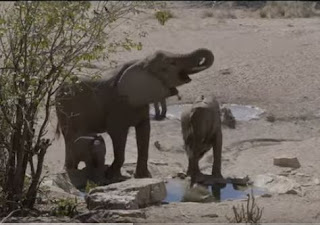African elephants usually wander among open grasslands or make their homes in forests. However, in northwest Namibia, they have fallen in love with an arid landscape of rocky mountains, sand, and gravel plains. These pachyderms have adapted to life in the desert. Incidentally, there are two populations of desert-adapted elephants in the world. In order to survive in this harsh environment, they have developed larger feet. These help them to move more easily across soft sandy terrain. These also serve as a useful tool, along with their trunks, to find water deep beneath the ground. Moreover, like other desert animals, they can survive for several days without water. In fact, they store water in a pharyngeal pouch in their throats. This helps them to collect and store. Dr Malan Lindeque is a Namibian zoologist and expert in elephant population ecology. He explained to a section of the media – “They have an excellent group memory – presumably held mostly by the adults – and knowledge of widely dispersed sources of water, which enable these elephants to move over very large areas, the largest home ranges recorded for elephants anywhere.” Desert elephants are finding friends in the drylands of Namibia.
He went on to add that while other elephants will seek food and water within a 12.4-mile radius, desert elephants can move 62 to 93 miles a day between waterpoints. This is “often in a quite straight line, demonstrating their knowledge of the location of these sites.” A conservation organization in Namibia says an estimated 62 desert dwelling elephants live in the dried up riverbeds of Namibia. This is only a fraction of the thousands that used to live in the Namib region in the 18th century. The decline is because of factors like hunting, poaching, increase in human populations and political conflict. Even now, their survival is uncertain because of a scarcity of food and water and regular conflict with another species – humans. From an estimated 3 to 5 million African elephants at the beginning of the 20th century, only 400,000 remain.
Some popular stories of this blogger –
Taiwan opens its doors to tourists after easing COVID-19 border curbs
Alaska cancels its snow crab harvest this year because of their disappearance from the Bering Sea in recent years
This year’s London Film Festival closed with ‘Glass Onion: A Knives Out Mystery’
SpaceX Crew-4 astronauts of NASA and ESA returned to Earth in a parachute-assisted splashdown
The mighty Mississippi River south of St. Louis is drying up because of drought
Greece depended entirely on renewable energy for five hours on a single day and used solar, wind and hydroelectric power
Prince Harry announced the return of Invictus Games to Canada in 2025 for the first-ever winter sports edition
Another incident of gun violence in North Carolina kills five, police arrests a 15-year-old boy
Unique flower market of Kolkata at Mullick Ghat on the banks of the Hooghly


No comments:
Post a Comment